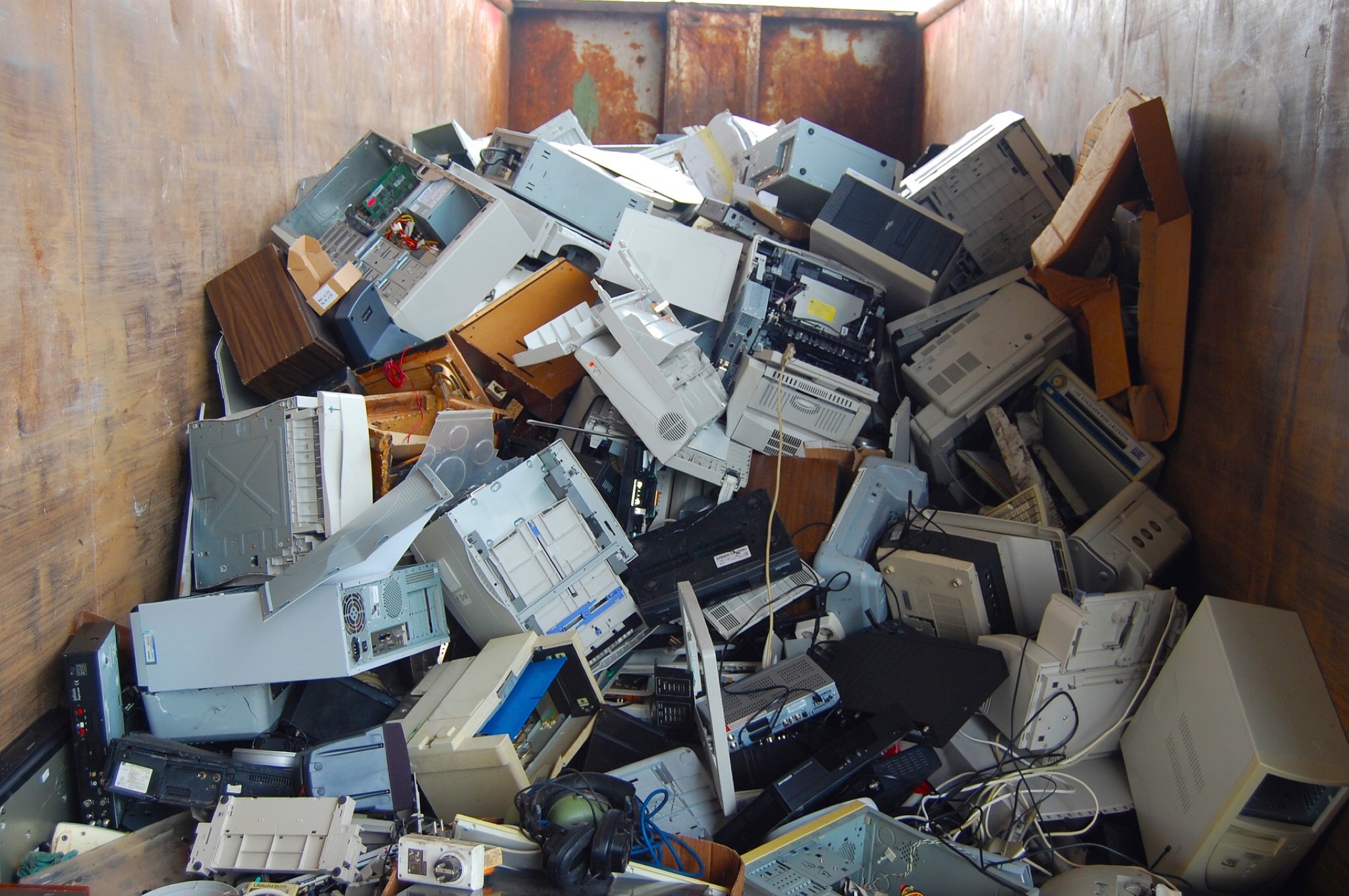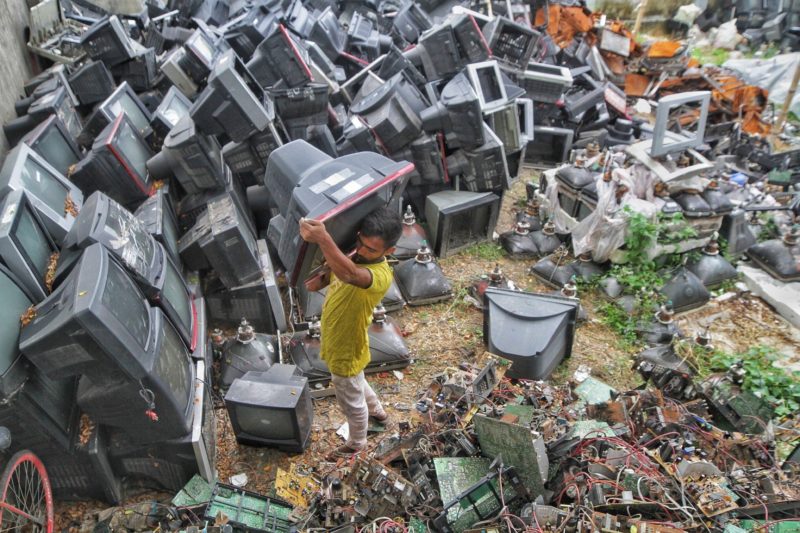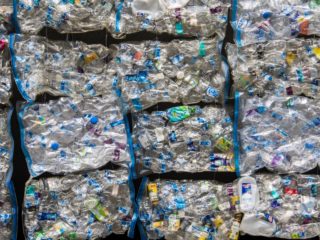When you think of the main culprit in our global waste crisis, do you think of plastic? I do, but a fierce contender is now e-waste. As we grapple with the environmental issues related to handling humans’ ability to generate ever-increasing quantities of waste, we’ll need to add electrically-powered devices to the list.
What is E-Waste?

E-Waste – a nickname for electronic waste – is a catchall term for all electrical and electronic equipment (EEE) and electronic products that have reached the end of their useful life.
E-waste examples include:
- IT and related telecommunication items: Computers, computer monitors, printers, keyboards, cell phones, telephones, tablet devices, laptops, inkjet cartridges, chargers.
- Household appliances and equipment: washer/dryers, refrigerators, dishwashers, freezers, air conditioners, vacuum cleaners, small kitchen appliances (microwaves, toasters, electric kettles).
- Household electronics: TVs, digital cameras, game consoles, DVD players, home entertainment systems, small household electronics (calculators, electronic toys).
- Lighting and related items: fluorescent lights and lightbulbs, LED lamps and lightbulbs.
E-waste does not currently cover batteries or a vehicle’s electrical components.
As you can see, e-waste is an incredibly large category and one that includes a wide degree of variation related to economic value, health and environmental impacts, and proper handling and disposal. All this adds up to a high probability of confusion in how to safely dispose of an electronic product once it has reached the end of its useful life.
Why is it a Problem?

A Rapidly Expanding Waste Stream
The United Nation’s Global E-Waste Monitor reports that a record 53.6 million metric tonnes (approximately 59.1 million U.S. tons) of electronic waste was generated worldwide in 2019, up 21% in just five years. Thinking about that amount of waste in a different way, that’s the equivalent in weight of around 35 million cars or, in per capita terms, an average of 16 lbs for every man, woman and child on Earth!
The report also predicts that global e-waste will nearly double in just 16 years, making it the world’s fastest-growing domestic waste stream.
What accounts for this explosion in electronic waste? One reason is our intensified dependency on electronics, technological devices, and electronic equipment to sustain our lives. Compounding the problem is shorter life-cycles for all these products. (Remember when a dishwasher lasted 15 or more years? Those days are gone.) Lastly, the ability to repair broken items is difficult and frequently more costly than simply buying the latest, new model.
Environmental and Health Hazards
Then there are environmental issues: Demand for natural resources in the manufacture of most electronic products and devices has depleted the stock of rare-earth minerals and precious metals, such as gold, silver, copper, zinc, and platinum. In fact, a new study of base metals used in the electronics industry estimates that demand for these metals will outstrip supply in the next two decades.
Other materials used in electronics production are toxic to humans and the environment. These chemicals and substances, when released through e-waste disposal, contribute to greenhouse gas emissions and climate change.
Along with environmental problems, there are a number of health hazards associated with e-waste. Many, if not most of these products, contain highly toxic substances, including mercury, cadmium, lead, flame retardants, barium, and lithium. Workers who process e-waste disposal face severe and life-threatening exposure to toxic chemicals and substances. And for those who live near places where e-waste is dumped or incinerated face health risks from leaching chemicals in groundwater and toxic air pollution.
Improper Disposal and Recycling
Even with the best of intentions, there is, understandably, consumer confusion associated with the proper disposal of electronic waste. Each electronic item, whether it’s a computer, calculator, dishwasher, LED bulb, or inkjet cartridge, needs to be disposed of in a specific manner. The burden is on the consumer to figure it all out.
It doesn’t help that the U.S. has no national e-waste legislation to manage disposal and recycling. Instead, consumers are left to follow state or local guidelines that vary in scope and impact. Some states have passed e-waste legislation, but even in states with more stringent disposal rules, e-waste collection options are woefully inadequate given the scope of the problem.
It comes as no surprise, therefore, that electronics are one of the main recycling contaminants found in curbside recycling bins.
Where does all this e-waste actually end up? It’s unclear. Nearly 80% of all global e-waste produced in 2018 remained “undocumented with an unknown fate.” Of the waste that’s accounted for, only 17 percent of global e-waste was collected and recycled (approximately 35 percent in the U.S.).
Dissembling and recycling electronic devices is complicated and labor-intensive, increasing the chances that they won’t be appropriately processed. All too often, e-waste is dumped (sometimes illegally) in landfills, incinerated, or left as pollution, exposing toxic substances to humans and the environment.
E-Waste Solutions

Donate
What can you do to safely dispose of your electronics and electrical equipment? One solution is to donate your unwanted items. Some options for donation include:
National Charities:
- Habitat for Humanity ReStores
- National Coalition Against Domestic Violence
- Secure the Call organization
- Goodwill
- National Cristina Foundation
- Donate NYC (NYC metro area)
Local. Local thrift and second-hand stores, religious institutions, educational institutions, and community civic organizations.
Online. Buy Nothing social media groups or community Facebook groups.
Sell Your E-Waste
Instead of tossing your unwanted devices, why not sell them? Many companies offer buy-back programs or will offer store credit. Participating companies include:
- Amazon Trade-In
- Apple Trade-In
- Best Buy Trade-In
- It’s Worth More Trade-In
- Staples Trade-In
- Walmart Gadget to Gift Cards
- Office Depot Recycling Program
- Staples Ink Cartridge Recycling Program
To sell unwanted items yourself, try online options, including Craigslist and Freecycle. eBay Giving Works will donate 10% to 100% of the profits in any sale to a charity of your choice. You can also make a little money by selling large appliances that contain metal to a scrap metal recycler.
Dispose of E-Waste Responsibly
Local Resources. Check your hometown, county, and state websites for recycling and disposal information. Many states require companies to take back their unwanted products and will provide a list of the companies on their state websites.
Also, keep your eyes out for county and town recycling or zero waste days where you can bring your hard-to-recycle items to one central location.
In my home state, New York, the Department of Environmental Conservation lists collection site locations in each county. You can also email DEC with e-waste questions or concerns by contacting the E-waste Recycling Team.
Electronics TakeBack Coalition provides a list of takeback programs in the U.S.
E-Cycling Central has a searchable directory of reuse, recycling, and donation programs. Just click on the map to find a location near you.
Earth911 has a searchable database that allows you to search for how to dispose of dozens of types of e-waste. Simply input the electronic item and your zip code and it lists recycling or drop-off locations near you.
Electronics Recycling Coordination Clearinghouse maintains an updated list of states with e-waste laws. You can see details on each state’s legislation.









